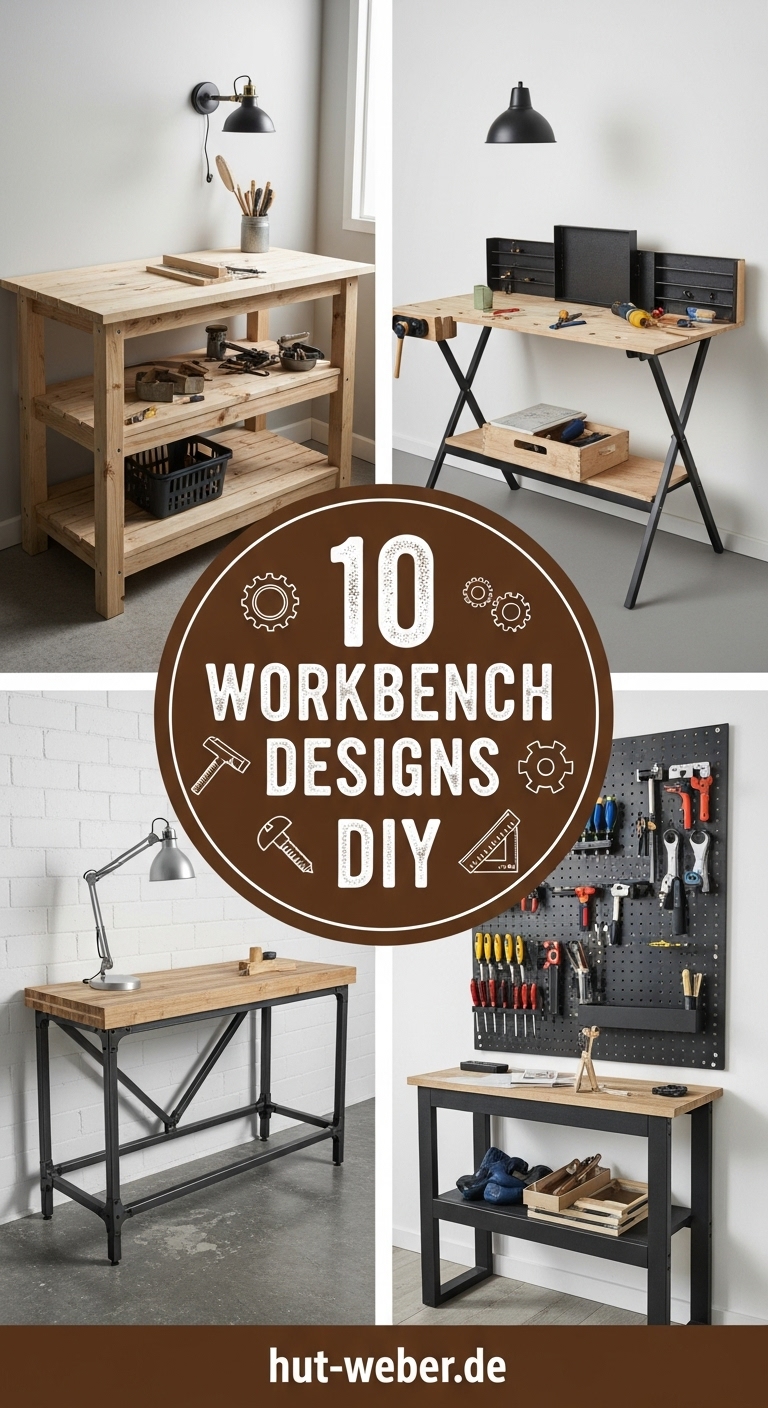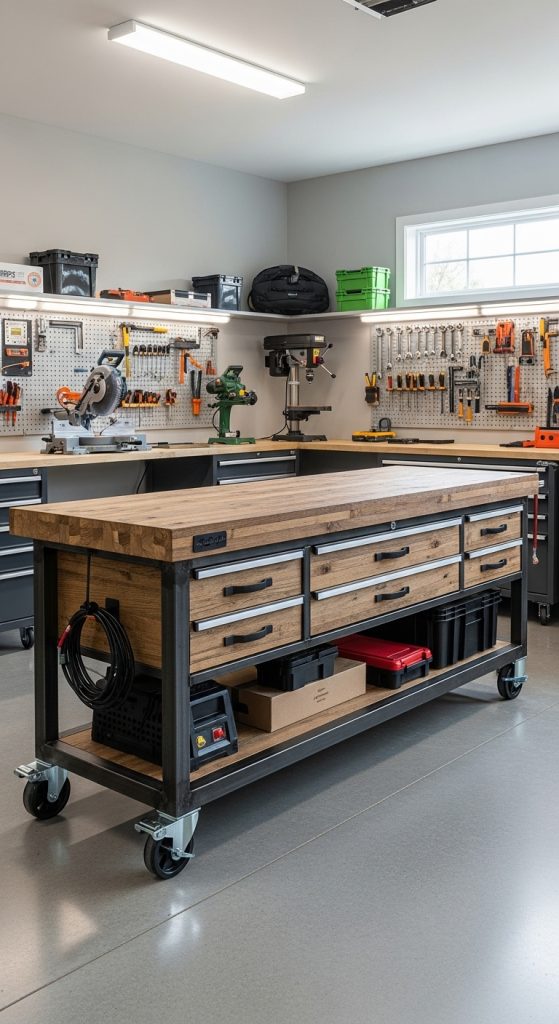
A workbench is the heart of any workshop. Whether you are a beginner woodworker, a weekend DIYer, or a professional builder, having the right workbench makes every project smoother and more enjoyable. The good news is that you do not need to buy an expensive ready-made workbench. With the right plans, some tools, and a bit of effort, you can build your own DIY workbench that perfectly fits your workspace and needs.
In this guide, we will go through 10 creative and practical DIY workbench designs. From small and foldable options for compact spaces to heavy-duty benches for serious woodworking, you will find inspiration for your next project. Each design focuses on durability, usability, and functionality, so you can get the most out of your workshop.

1. The Classic Sturdy Wooden Workbench
The classic wooden workbench is timeless for a reason. It is simple, strong, and versatile. Typically built from 2×4 or 4×4 lumber with a solid plywood or hardwood top, this design gives you a stable surface for cutting, sanding, and assembling. You can add a lower shelf for extra storage, making it a practical solution for most workshops.
The key benefit of this design is stability. A heavy-duty wooden frame prevents wobbling, and you can customize the size to match your space. This type of bench works well for beginners since the construction does not require complicated joinery. If you want extra durability, consider sealing the wood with polyurethane or attaching a thick hardwood top like maple or oak.

2. Foldable Wall-Mounted Workbench
For people working in small garages or shared spaces, a foldable wall-mounted workbench is a lifesaver. This design uses hinges to attach a sturdy tabletop to the wall. When you need the workspace, simply fold it down, and when you are done, fold it back up to save floor space.
This type of workbench can be built with simple lumber and strong wall brackets. The frame does not have to be bulky, yet it still offers excellent stability when folded down. It is especially useful for DIYers who live in apartments or homes with limited workshop space.
The best part is that you can even add small storage shelves above it, turning your wall into a compact workstation.

3. Mobile Workbench on Wheels
Mobility is key for many DIYers, especially if you often rearrange your garage or workshop. A mobile workbench on locking caster wheels allows you to move it wherever you need. It is perfect if you need to share space with a car in your garage or if you want to roll your tools closer to your project.
This design is usually built with a sturdy frame, a thick work surface, and heavy-duty casters that lock in place. You can customize it further with built-in drawers or shelves underneath. Some DIYers even integrate power strips into the bench so they can plug in tools directly.
This design combines flexibility with practicality, making it one of the most versatile DIY workbenches.

4. Heavy-Duty Workbench for Woodworking
If you are serious about woodworking, you need a heavy-duty bench that can handle hammering, sawing, and clamping without moving an inch. A woodworking workbench usually has a thick hardwood top, wide legs, and multiple clamping options.
Many traditional woodworking benches also include a vise attached to the front or side, making it easier to hold wood pieces firmly while working. Dog holes drilled into the top allow you to use bench dogs and clamps for additional support.
Though this type of bench requires more time and effort to build, the payoff is worth it. Once finished, it will last for decades and become a centerpiece in your workshop.

5. Workbench with Built-In Storage
One of the smartest designs is a workbench that doubles as a storage unit. Instead of leaving the space underneath empty, you can add shelves, cabinets, or drawers. This keeps your tools, screws, and materials within easy reach and saves space in smaller workshops.
You can design this in many ways. Some people prefer open shelves for quick access, while others like enclosed cabinets to keep everything dust-free. Adding a pegboard to the back of the workbench is another excellent idea, letting you hang tools neatly where you can see them.
This type of DIY workbench is especially helpful for hobbyists who do not have a large toolbox or separate storage area.

6. Workbench with Built-In Tool Stand
If you frequently use stationary tools like a miter saw, table saw, or drill press, a workbench with a built-in tool stand can be a game changer. This design integrates your power tools into the bench itself, creating a stable and organized setup.
For example, many DIYers build a long workbench with their miter saw in the center, flush with the tabletop. This makes cutting long boards easier since the bench itself supports the material. You can also cut out spaces to mount other tools, making your workbench the central hub of your shop.
It requires careful planning, but once built, this design saves a ton of time and effort during projects.

7. Outdoor DIY Workbench
Not every workshop is indoors. If you enjoy gardening, painting, or working on messy projects, an outdoor workbench is a fantastic addition. Built with pressure-treated wood or weather-resistant materials, this type of bench can withstand the elements.
Outdoor workbenches are usually simple in design, often with a slatted or solid top, and may include hooks or shelves for gardening tools. Some even double as potting benches for garden enthusiasts.
By keeping your messy projects outside, you free up space inside and keep your home cleaner. An outdoor workbench is also a great choice if you lack space in your garage.

8. Small Compact Workbench
Sometimes, less is more. A compact workbench is ideal for hobbyists who need a dedicated space but do not require a massive structure. This design usually measures between 2 to 4 feet wide and can be placed in the corner of a garage, basement, or spare room.
Compact benches can still be highly functional. You can build one with a sturdy wooden top and add small shelves underneath for storage. Some people even design fold-out extensions to expand the workspace when needed.
The main advantage is that it does not take up much room, making it a smart choice for beginners, renters, or those with limited space.

9. Workbench with Reclaimed Materials
Building a workbench does not have to be expensive. In fact, some of the best DIY benches are made from reclaimed wood, old doors, or repurposed furniture. This design not only saves money but also gives your workshop a unique, rustic look.
For example, you can repurpose an old solid-core door as the tabletop and build the frame from leftover 2x4s. You can even reuse kitchen cabinets as the base, instantly creating a bench with built-in storage.
This sustainable approach adds character and creativity to your workspace while reducing waste.

10. Modular Multi-Purpose Workbench
A modular workbench is one of the most advanced DIY designs. Instead of being just a flat surface, it is built to adapt to different projects. Some modular benches feature adjustable height, interchangeable tops, or detachable sections that can be rearranged.
For example, you might design a bench with removable panels that allow you to swap between a cutting surface, a sanding station, or a tool mount. Others include sliding drawers that act as extra work surfaces when pulled out.
Though this design takes more planning and skill, it is incredibly rewarding. If you enjoy experimenting with different DIY projects, a modular bench will be your ultimate workshop companion.

Tips for Building Your DIY Workbench
- Plan the size carefully. Measure your available space before cutting any wood.
- Use strong joinery. Screws, bolts, and brackets add strength to the frame.
- Level the top surface. A perfectly flat surface ensures accuracy in woodworking projects.
- Consider height. Standard workbenches are 34 to 36 inches tall, but adjust to your comfort.
- Choose the right top. Plywood is affordable, hardwood is durable, and MDF offers a smooth finish.
- Add power outlets. If possible, mount a power strip to keep tools within reach.
- Think long-term. Build with quality materials so your bench lasts for years.
Final Thoughts
A DIY workbench is more than just a table. It is the foundation of your creativity, the stage where every project begins and ends. By building your own, you not only save money but also create a piece that matches your exact needs and workshop style.
From foldable wall-mounted options for small spaces to heavy-duty benches built to last decades, the possibilities are endless. Whether you choose a simple compact design or an advanced modular setup, the satisfaction of working on a bench you built yourself is unmatched.
Pick one of the ten workbench designs above and start planning your next DIY project. Your workshop will thank you.


